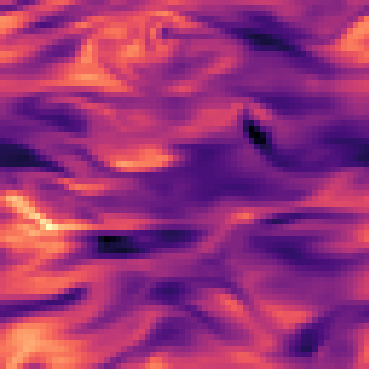Datasets:
File size: 4,814 Bytes
d166dec |
1 2 3 4 5 6 7 8 9 10 11 12 13 14 15 16 17 18 19 20 21 22 23 24 25 26 27 28 29 30 31 32 33 34 35 36 37 38 39 40 41 42 43 44 45 46 47 48 49 50 51 52 53 54 55 56 57 58 59 60 61 62 63 64 65 66 67 68 69 70 71 72 73 74 75 76 77 78 79 80 81 82 83 84 85 86 87 88 89 90 91 92 93 94 95 96 97 98 99 100 101 102 103 104 105 106 107 108 109 110 111 112 113 |
---
language:
- en
license: cc-by-4.0
tags:
- physics
task_categories:
- time-series-forecasting
- other
task_ids:
- multivariate-time-series-forecasting
---
# How To Load from HuggingFace Hub
1. Be sure to have `the_well` installed (`pip install the_well`)
2. Use the `WellDataModule` to retrieve data as follows:
```python
from the_well.benchmark.data import WellDataModule
# The following line may take a couple of minutes to instantiate the datamodule
datamodule = WellDataModule(
"hf://datasets/polymathic-ai/",
"MHD_64",
)
train_dataloader = datamodule.train_dataloader()
for batch in dataloader:
# Process training batch
...
```
# Magnetohydrodynamics (MHD) compressible turbulence
**NOTE:** This dataset is available in two different resolutions \\(256^3\\) for `MHD_256` and \\(64^3\\) for `MHD_64`. The data was first generated at \\(256^3\\) and then downsampled to \\(64^3\\) after anti-aliasing with an ideal low-pass filter. The data is available in both resolutions.
**One line description of the data:** This is an MHD fluid flows in the compressible limit (subsonic, supersonic, sub-Alfvenic, super-Alfvenic).
**Longer description of the data:** An essential component of the solar wind, galaxy formation, and of interstellar medium (ISM) dynamics is magnetohydrodynamic (MHD) turbulence. This dataset consists of isothermal MHD simulations without self-gravity (such as found in the diffuse ISM) initially generated with resolution \\(256^3\\) and then downsampled to \\(64^3\\) after anti-aliasing with an ideal low-pass filter. This dataset is the downsampled version.
**Associated paper**: [Paper](https://iopscience.iop.org/article/10.3847/1538-4357/abc484/pdf)
**Domain expert**: [Blakesley Burkhart](https://www.bburkhart.com/), CCA, Flatiron Institute & Rutgers University.
**Code or software used to generate the data**: Fortran + MPI.
**Equation**:
```math
\begin{align}
\frac{\partial \rho}{\partial t} + \nabla \cdot (\rho \mathbf{v}) &= 0 \nonumber\\
\frac{\partial \rho \mathbf{v}}{\partial t} + \nabla \cdot (\rho \mathbf{v} \mathbf{v} - \mathbf{B} \mathbf{B}) + \nabla p &= 0 \nonumber\\
\frac{\partial \mathbf{B}}{\partial t} - \nabla \times (\mathbf{v} \times \mathbf{B}) &= 0 \nonumber\\
\end{align}
```
where \\(\rho\\) is the density, \\(\mathbf{v}\\) is the velocity, \\(\mathbf{B}\\) is the magnetic field, \\(\mathbf{I}\\) the identity matrix and \\(p\\) is the gas pressure.

| Dataset | FNO | TFNO | Unet | CNextU-net
|:-:|:-:|:-:|:-:|:-:|
| `MHD_64` | 0.3605 | 3561 |0.1798|\\(\mathbf{0.1633}\\)|
Table: VRMSE metrics on test sets (lower is better). Best results are shown in bold. VRMSE is scaled such that predicting the mean value of the target field results in a score of 1.
# About the data
**Dimension of discretized data:** 100 timesteps of 64 \\(\times\\) 64 \\(\times\\) 64 cubes.
**Fields available in the data:** Density (scalar field), velocity (vector field), magnetic field (vector field).
**Number of trajectories:** 10 Initial conditions x 10 combination of parameters = 100 trajectories.
**Estimated size of the ensemble of all simulations:** 71.6 GB.
**Grid type:** uniform grid, cartesian coordinates.
**Initial conditions:** uniform IC.
**Boundary conditions:** periodic boundary conditions.
**Data are stored separated by (\\(\Delta t\\)):** 0.01 (arbitrary units).
**Total time range (\\(t\_{min}\\) to \\(t\_{max}\\)):** \\(t\_{min} = 0\\), \\(t\_{max} = 1\\).
**Spatial domain size (\\(L_x\\), \\(L_y\\), \\(L_z\\)):** dimensionless so 64 pixels.
**Set of coefficients or non-dimensional parameters evaluated:** all combinations of \\(\mathcal{M}_s=\\){0.5, 0.7, 1.5, 2.0 7.0} and \\(\mathcal{M}_A =\\){0.7, 2.0}.
**Approximate time and hardware used to generate the data:** Downsampled from `MHD_256` after applying ideal low-pass filter.
# What is interesting and challenging about the data:
**What phenomena of physical interest are catpured in the data:** MHD fluid flows in the compressible limit (sub and super sonic, sub and super Alfvenic).
**How to evaluate a new simulator operating in this space:** Check metrics such as Power spectrum, two-points correlation function.
Please cite the associated paper if you use this data in your research:
```
@article{burkhart2020catalogue,
title={The catalogue for astrophysical turbulence simulations (cats)},
author={Burkhart, B and Appel, SM and Bialy, S and Cho, J and Christensen, AJ and Collins, D and Federrath, Christoph and Fielding, DB and Finkbeiner, D and Hill, AS and others},
journal={The Astrophysical Journal},
volume={905},
number={1},
pages={14},
year={2020},
publisher={IOP Publishing}
}
```
|